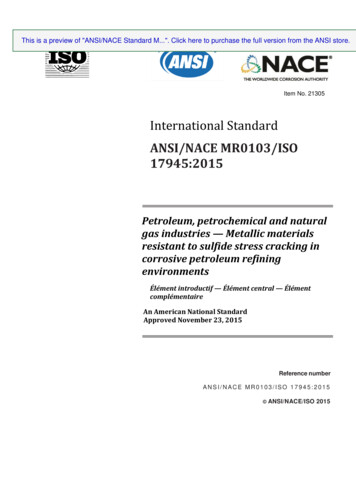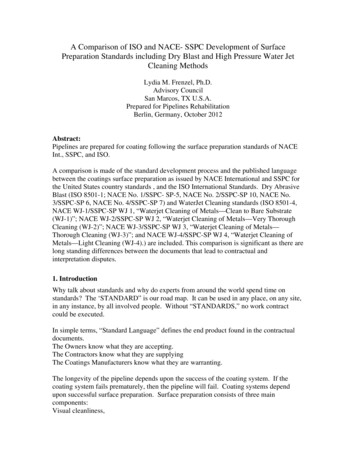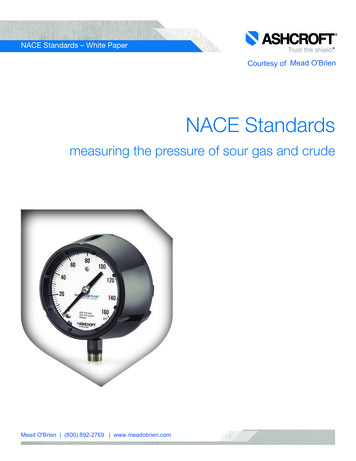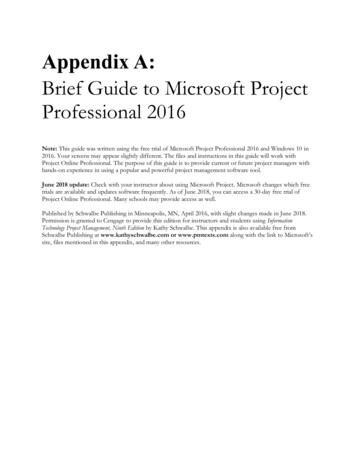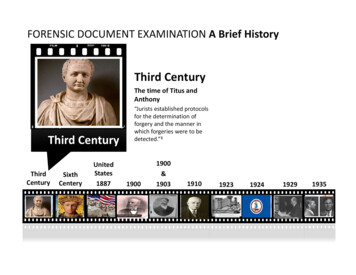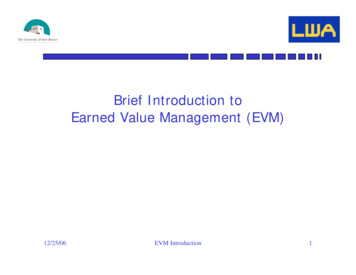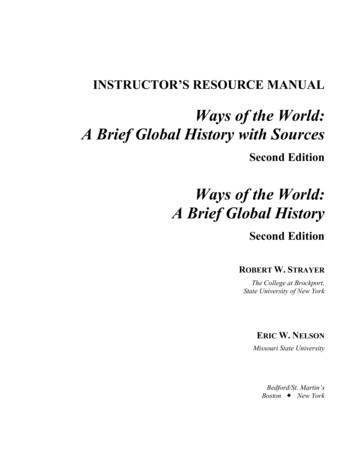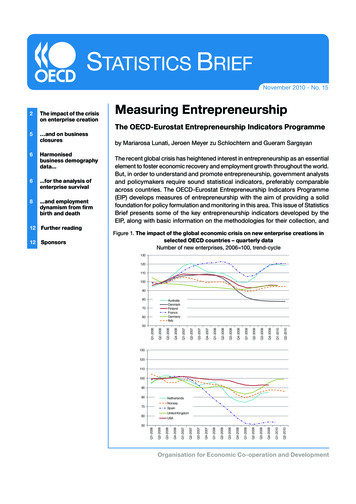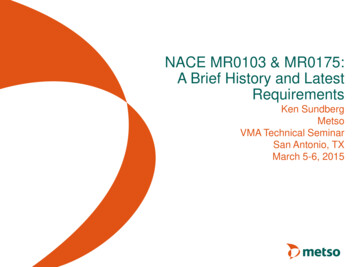
Transcription
NACE MR0103 & MR0175:A Brief History and LatestRequirementsKen SundbergMetsoVMA Technical SeminarSan Antonio, TXMarch 5-6, 2015
NACE MR0175 & MR0103INTERNALOverview NACE – A Look Back Benefits to end-user MR0103 & MR0175 Material Requirements, Limitations & ServiceRestrictions2 MetsoDate Author Title
Current NACE SpecificationsINTERNAL NACE MR0175/ISO 15156 – 2009 Petroleum and natural gas industries— Materials for use in H2S-containing environments in oil and gasProduction- PART 1 - General principles for selection of cracking-resistant materials- PART 2 - Cracking-resistant carbon and low-alloy steels, and the use of cast irons- PART 3 - Cracking-resistant CRAs (corrosion resistant alloys) and other alloys- currently set to be revised again (2014 version) NACE MR0103 – 2012 Materials Resistant to Sulfide Stress Cracking inCorrosive Petroleum Refining Environments3 MetsoDate Author Title
NACE – A Look BackINTERNALHighlights 1930’s Focus was on cathodic protection for underground pipes The Mid-Continent Cathodic Protection Association (MCPA) held its first meeting onMarch 9, 1936 and met again on April 27, 1938 Up until 1939, the MCPA operated separately, when they joined API as the CathodicProtection Subcommittee4 MetsoDate Author Title
NACE – A Look BackHighlights 1940’s In 1940 the MCPA became affiliated withthe Petroleum Industry ElectronicAssociation (PIEA) In 1942, MCPA attempted to revise thebylaws, which were rejected by PIEA.This drove members of MCPA toconsider forming an independent group,specifically addressing corrosion. Several meetings over the summer of1943 were held and on October 10 & 11,1943 the National Association ofCorrosion Engineers (NACE) wasformed. Sour gas and affects of the gas wereexperienced in the oil & gas industriesstarting in West Texas, Ginger Field inthe late 1940’s to early 1950’s.5 MetsoDate Author TitleINTERNAL
NACE – A Look BackINTERNALHighlights, Con’t Early 1950’s The Canadian Jumping Pound and Pincher Fields came on experiencing similar issueswith sour gas The Canadian failures were attributed to Sulfide Stress Cracking (SSC).o Considerable effort was put forth to understand and solve the Canadian failures,which would ultimately lead to safe and reliable production NACE formed the T-1G committee The purpose of the committee was to gather data and attempt to solve the H2Scracking failureso NOTE: Many on the committee feared that if there was a disastrous event thatthe government would step in and require its own controls. The governmentstandard could also hinder discussions and developments which encouraged fluidand technical discussions.6 MetsoDate Author Title
NACE – A Look BackINTERNALHighlights, Con’t 1952 The T-1G committee held a SSC Symposium Multiple papers were presented discussing ten (10) failures seen in the field. They concluded that the failures resulted from improper material selection and how thematerial was processed, both of which made the materials vulnerable to H2S. 1962 The early committee work occurred in a Canada industry group that became T-1B The T-1B section released a report that addressed material recommendations for sourgas service in well equipment 1963 NACE formed task group T-1F, which combined the activities of other task groupactivities They began to write valve document 1F1667 MetsoDate Author Title
NACE – A Look BackINTERNALHighlights, Con’t 1966 T-1F issued 1F166 – “Sulfide Cracking Resistant Materials for Valves for Productionand Pipeline Service” 1F166 consisted ofo Production and pipeline valve document for wellhead valves up to 15,000 psiserviceo Consistent manufacturing methodso Gate valve materials 1975 1F166 was transitioned into a Materials Requirement for Valves and issued asMR0175, which became an industry standard for Christmas tree valves8 MetsoDate Author Title
NACE – A Look BackINTERNALHighlights, Con’t Between 1975 and 1978 Several SSC failures were experienced by the Texas Railroad Commission, which leadthem to require MR0175 for all production equipment This became common throughout the refining industry up until MR0103 wasissued 1978 Scope of MR0175 was expanded to include all equipment 1984 MR0175 stopped using material trade names and referenced UNS or SAE numbers(concerned with liable action if they limited the approved materials to the trade names) Late 1990’s The scope of MR0175 was expanded to include SSC cracking caused by chlorides NACE approached ISO to create a global standard addressing sour environmentscombining the work done by NACE and European Federation of Corrosion (EFC)9 MetsoDate Author Title
NACE – A Look BackHighlights, Con’t 2000 NACE task group 231 was formed to create a refinery standard for sour gaso Would later become MR0103 2002 By this time issues with MR0175 had accumulated since 1975o High temperature SSC of the corrosion resistant alloyo Inconsistent alloy requirementso Unclear rules for alloyso Differing interpretations10 MetsoDate Author TitleINTERNAL
NACE – A Look BackINTERNALHighlights, Con’t Early 2003 MR0175 splits into MR0175 & MR0103 MR0175-2003o Intended for oilfield production where H2S and saltwater/brine was presento Many materials previously allowed were either discontinued or heavily restricted– Updated austenitic stainless steel requirements, which meant 300 seriesstainless steels may not meet the environmental requirements it once mayhave meto Clarified welding requirements for carbon steels MR0103-2003o Intended for sour refinery applications or other sour services but withoutsaltwater/brineo Very similar to MR0175 pre-200311 MetsoDate Author Title
NACE – A Look BackINTERNALHighlights, Con’t December 2003 NACE MR0175/ISO 15156 1ST Edition is issued 2004 to Present Updates to MR0103 & MR0175/ISO15156 have consisted of adding or removingmaterial requirements12 MetsoDate Author Title
INTERNALNACE – A Look BackHighlights, Con’t: MR0175-2003 vs MR0103-2003MR01752003Addressed fact thatoilfield applications tendto contain both HydrogenSulfide & ChloridesOld materials eitherremoved orseverelyrestrictedMR01032003Refinery applicationsdo not need protectionfrom ChloridesNo changein allowedmaterials fromold MR0175MR0175Prior to 2003Recommendedmaterials forHydrogen Sulfideservices13 MetsoDate Author Title
NACE MR0175 & MR0103INTERNALBenefit to the end-user Per MR0175/ISO 15156 the purpose is to provide “general principles andgives requirements and recommendations for the selection andqualification of metallic materials for service in equipment used in oil andgas production and in natural-gas sweetening plants in H2S-containingenvironments .” Per MR0103, the purpose is to “establishes material requirements forresistance to SSC in sour petroleum refining and related processingenvironments containing H2S either as a gas or dissolved in an aqueous(liquid water) phase with or without the presence of hydrocarbon.” In short, these standards reduce the risk of H2S related cracking failuresin equipment Benefits- Material requirements and recommendations for intended service- Minimizes health and safety accidents- Avoids equipment failures- Can extend the life of equipment that could have been subjected to H2S cracking14 MetsoDate Author Title
INTERNALNACE MR0103 & MR0175Material Requirements, Limitations & Service RestrictionsRequirements & Limitations(general overview)MaterialRequirementsServiceRestrictions15 MetsoNACENACEMR0175 MR0103Acceptable MaterialsxxHardness LimitsxxHeat Treatment LimitationsxxMaterial Condition LimitationsxxChemical CompositionsxxWelding (Fabrication)xxExposed BoltingxxSpecial Component Material RequirementsxxEnvironment Exposure RestrictionsxDate Author Title
NACE MR0103 & MR0175INTERNALMaterial Requirements, Limitations & Service Restrictions Not all of the requirements and limitations listed on the previous page arerequired for every material in every standard These standards only address material cracking in H2S environments All other types of failure modes need to be addressed separately by end-user Allowable environmental conditions for approved uses-MR0175 – environmental conditions are well definedMR0103 – as compared to MR0175 environmental conditions are not as well definedfor the end-user. End-user judgment on conditions may be required. As an example,field experience of an unlisted alloy may be used as justification for its use End-user is responsible to determine:-16Operating conditionsIf their application falls within MR0175 or MR0103If the material is satisfactory for a given service MetsoDate Author Title
NACE MR0103 & MR0175INTERNALMaterial Requirements, Limitations & Service Restrictions To fully specify valve compliant to NACE MR0175-2003 or newer version,the end-user must define the following environmental restrictions:- Max temperature- Max system pressure- Existence of elemental sulfur- Max chloride content- pH- Partial pressure of H2S- Will the valve be buried or insulated? Manufacturer is responsible to comply with requirements set forth byend-user & to ensure the materials supplied to the end-usermetallurgically comply with NACE standards Purchasing a NACE compliant product only means the materials conformto NACE. It does not mean that the selected material is acceptable forall NACE MR0175 services.17 MetsoDate Author Title
ReferencesINTERNAL References:18 D.H. Patrick, “MR0175 – A HISTORY AND DEVELOPMENT STUDY”, Paper No.418, 1999 D. Bush, J. Brown & K. Lewis, “AN OVERVIEW OF NACE INTERNATIONALMR0103 AND COMPARISON WITH MR0175”, Paper No. 04649, 2004 NACE, “NACE MR0175/ISO 15156 2009 2ND Edition”, NACE International Seminar,February 13, 2013 W. Brian Holtsbaum & Pierre Crevolin, “The History of NACE International TheCorrosion Society, 1943-2013, 70 Years of Progress”, 2013 NACE MR0103, Multiple Versions NACE MR0175, Multiple Versions MetsoDate Author Title
oworldmetsogroup
NACE, “NACE MR0175/ISO 15156 2009 2ND Edition”, NACE International Seminar, February 13, 2013 W. Brian Holtsbaum & Pierre Crevolin, “The History of NACE International The Corrosion Society, 1943-2013, 70 Years of Progress”, 2013 NACE MR0103, Multiple Versions NACE MR0175, Multiple Versions 18 Date Author Title INTERNAL
